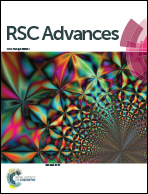The activation of N-glycosidic bond cleavage performed by base-excision repair enzyme hOGG1; theoretical study of the role of Lys 249 residue in activation of G, OxoG and FapyG†
Abstract
The activation of N-glycosidic bond cleavage performed by the lysine 249 (Lys 249) residue of base-excision repair enzyme hOGG1 was calculated for 2′-deoxyguanosine (G), 8-oxo-2′-deoxyguanosine (OxoG) and N6-(2′-β-D-deoxyribofuranosyl)-2,6-diamino-4-hydroxy-5-formamidopyrimidine (FapyG). The interaction sites of Lys 249 included the C1′, N3, and N9 atoms of the nucleosides. The N9-pathway, specifically the attack of lone-pair electrons of glycosidic nitrogen N9 of a nucleoside on the proton of the Nε-ammonium group of Lys 249, resulted in effective activation of the C1′–N9 bond that was highly specific with respect to normal (G) and damaged (OxoG, FapyG) nucleosides. The specificity of the N9-pathway was because of the electrophilic (G) or nucleophilic (OxoG, FapyG) character of the glycosidic nitrogen and because of the specific interactions of the residues within the catalytic pocket with the substrate (particularly the Gly 42 hOGG1 residue) that enforced the displacement of G out of the interaction range of Lys 249. The chemical modifications of G owing to damage specifically affected a number of molecular properties, particularly the electrophilicity/nucleophilicity of N9 and the C1′–N9 bond order and the aromatic character of the nucleobases. The N9-pathway could be involved as a check-point mechanism during base-excision performed by hOGG1.


 Please wait while we load your content...
Please wait while we load your content...